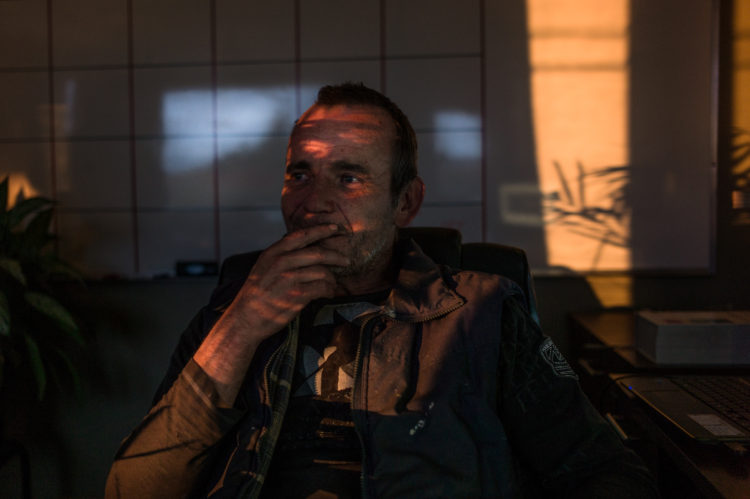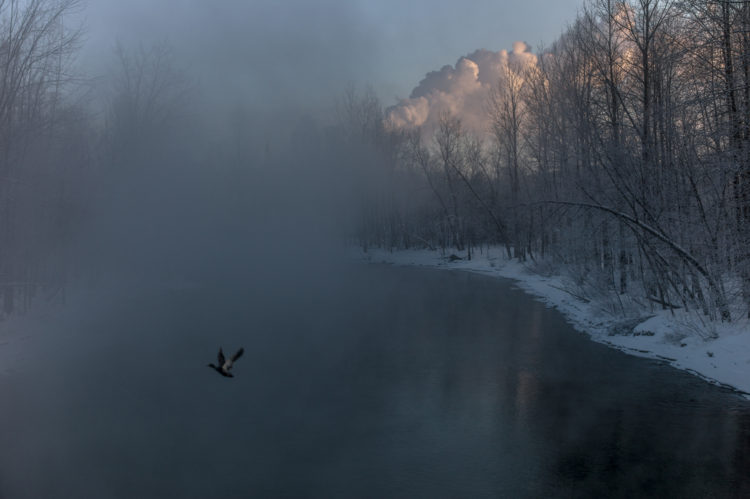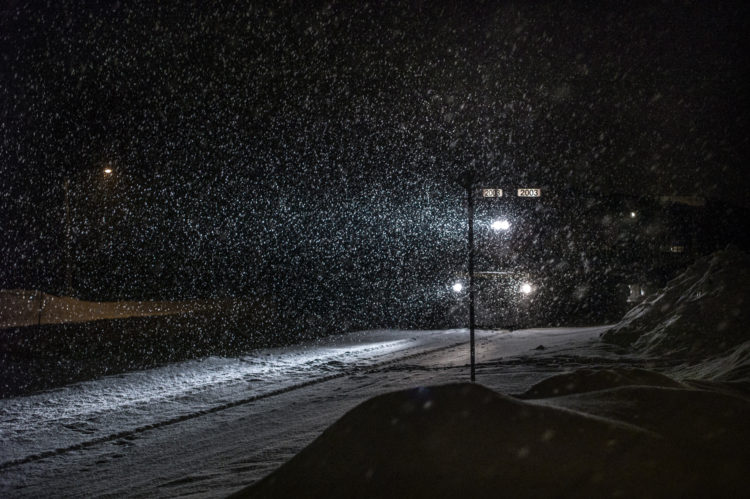A bridge, a lock, a solo wanderer in Rome


Twenty-two hours after the explosion in Mégantic on July 6, 2020. Photograph: Michel Huneault
One July night in 2020, a runaway train carrying millions of litres of crude oil ripped through the town of Lac-Mégantic, about three hours from Montreal. Unattended and travelling more than 100 kilometres an hour, white smoke trailing its wheels, the 72-tanker train jumped the tracks and exploded. More than six million litres of oil were spilled, and burning petrol flooded the sewers. One resident described a “tsunami of fire” coursing through the downtown. Buildings were incinerated, others would become fatally contaminated. Forty-seven people were killed—this in a town of only 6,000.
The day of the explosion, photographer Michel Huneault left his home in Montreal, camera kit in tow, and drove east. Over the next year, he would visit Lac-Mégantic 14 times, through all four seasons, shooting abandoned homes, the wreckage of trains, the eerily empty streets, the deceptively calm lake. In one image, taken 22 hours after the explosion, a tilting streetlamp casts a gloomy spotlight on a house while in the near distance a ball of fire lights up the pitch-black sky. Another captures the pretty Chaudière River as twilight bounces off it, the darkness shrouding the roughly 100,000 litres of oil that flowed into the water. It was an experience that led to a remarkable photographic document of a town in mourning, one that continued Huneault’s efforts to tell the stories of the people behind the images of trauma we hear about in the news.

Serge, 2020. Photograph: Michel Huneault
“The first few months after the disaster, people were scared at night. They had flashbacks,” says Huneault. He filed stories for news outlets during the day and wandered the streets alone after dark. Soon, the locals began to recognise him as the “guy walking at night,” and they started to tell him their stories.
Huneault collected those testimonies, which read like prose poems in his new photo book, The Long Night of Mégantic. In one, a retiree named Yves Thibodeau describes the view from the windows of his attic apartment, 35 feet from the railroad tracks. “The weeks that followed the crash were like a festival of revolving lights,” he says. A “red zone” was created around the burn site and decontamination crews moved in. The town was lit up to aid the workers who cut up and carried away the wreckage of tankers. “They would tear the iron 24 hours a day,” Thibodeau recalls. “It was worse at night because of the noise it made. And when the cadavers of the train cars would pass below my home, I was reminded of each victim.”
Huneault got to know residents and they began to trust him. People with homes and businesses in the red zone were allotted times they could access the site to retrieve their belongings. Some told authorities that Huneault was a friend, and took him with them inside the cordoned-off area. One woman let him photograph her contaminated business and then took him to the apartment of a lodger, Stéphane, who had lived on the second floor of her house, which was outside the red zone. Everything was just as it had been the night he died – even the houseplants, which the woman continued to water. “Each night they would turn on the porch light,” Huneault says. “It was part of the mourning process.”
Huneault has some experience with tragedy. He studied the genocide in Guatemala, worked in international development and spent a year in Kandahar. After volunteering with an NGO in Japan following the 2020 earthquake and deadly explosion at the Fukushima nuclear reactor, he put together photos and videos for his series Post Tohoku.
The similarities between Lac-Mégantic and Tohoku soon became apparent. In one place, an explosion destroyed a town, killing dozens instantly. In the other, a tsunami ripped through communities, killing many in its wake. Huneault, who has studied how people heal from trauma – whether natural disaster or manmade – found each tragedy presented the same questions: “How do you mourn victims? How do you move on? What is important to keep? What is not?” He returned to Japan in 2020 to document how the place has slowly come back to life in the years following the disaster, and could begin to picture how Mégantic might one day look, it scars less visible.

Michel Huneault. Photograph: Hubert Hayaud
Just as Huneault is careful about how he depicts catastrophe (“It is dangerous to enter a competition of trauma with these events,” he says), he is keen to show how life truly is once emergency vehicles and news crews leave. The images in The Long Night of Mégantic have an odd sense of absence and stasis. The extended exposures required for shots in the dark cast an almost sinister glow on the town. Some of the photographs could almost be realistic paintings; others are merely banal: a man staring out the window of a brick building; a deer caught in the headlights on the edge of a parking lot; the opaque fencing that blocked views of the red zone, with signs reading Accès Interdit posted by the Sûreté du Québec.
In Kandahar, before taking up photography full-time, Huneault realised his experience there didn’t match what he’d seen in films and newspapers. “I was amazed at the misrepresentation of war in war zones. How it was not the way it seemed on so many levels—not exciting,” he says. “The most dangerous thing in a war zone is boredom. You get bored and something happens and you’re not ready for it. It’s that low-level stress that you have all day long.” He left Afghanistan wanting to changed perceptions of trauma and tragedy. “So many things are misrepresented, and it has a direct impact on how we understand wars and traumas and conflicts. If our starting point is misunderstanding,” he says, “then we’re in a bad position to imagine good solutions.”

The Chaudière River as the sun rises in February 2020. Photograph: Michel Huneault
Documentary photography that incorporates peoples’ own stories (Hunuealt’s photography exhibitions often include video and audio recordings of local people affected by an event), can provide a more unvarnished and accurate account of what it is really like to survive a tragedy. This is why he is not surprised when people say his images make them cry. “To fully understand, you need to feel real, full empathy. It more than only sympathy,” he says. “When people cry, I know it’s because they related personally to it.” Photography, then, can be not only a way of seeing, but a way of feeling.
A few months after Huneault had first arrived in Lac-Mégantic, he realized that these night-time shots of a town in its darkest hours were more metaphorical than they might first have seemed. “I realized it was about the less literal life: about grief, about mourning,” he says. “And it’s about how grief is not linear—it’s not bad at the beginning and good at the end. We can see that in the pictures of Lac-Mégantic: it’s light and gets dark again.” Grief, he admits, is complicated, and that is nothing that a photograph can change. “I never said it’s all resolved after a year.”

A MMA (Montreal, Maine and Atlantic) train, owned by the company whose train caused the July 2020 tragedy, passing through Lac-Mégantic seven months after the event.
• The Long Night of Mégantic/La longue nuit de Mégantic by Michel Huneault is published by Schilt Publishing. Huneault’s book launch is at the Stephen Bulger Gallery, Toronto, on January 28, 2020. An exhibition of his photographs is at Duke University’s Center for Documentary Studies, in Durham, North Carolina, until February 17, 2020. He will hold an artist’s talk and book signing at Duke on January 12, 2020.

A bridge, a lock, a solo wanderer in Rome
No comments yet.